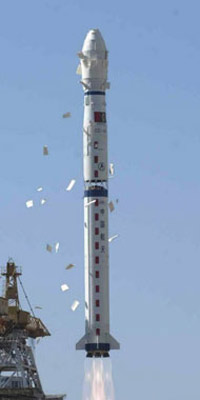- Joined
- Feb 13, 2008
- Messages
- 5,398
- Reaction score
- 8
- Points
- 0
- Location
- Khimki
- Website
- tigerofsiberia.livejournal.com
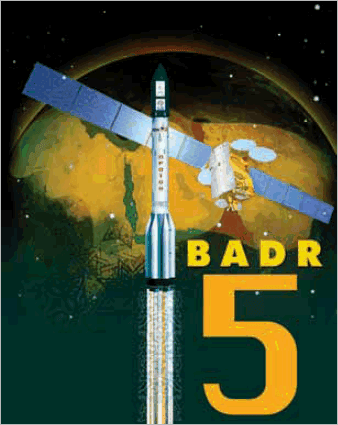


Launch site:
Baikonur Launch pad no. 200/39 46° 2'23.85"N, 63° 1'54.98"E
Launch date: June 4, 2010
The launch time is:
4:00:08 Baikonur 4.06.2010
2:00:08 Moscow Summer 4.06.2010
22:00:08 UTC June 3, 2010
6:00:08 p.m. EDT June 3, 2010
[eventTimer]2010-06-03 22:00:08?before|after;%dd% Days %hh% Hours %mm% Minutes %ss% Seconds %c%[/eventTimer] BADR-5 Launch
Payload: BADR-5 (aka ArabSat-5B) broadcasting satellite
Target orbit: GEO
Orbital slot: 26°E
Contract Life: 15 years
Coverage: The Middle East and North Africa (MENA)
The Badr-5 mission will be the 6th Proton launch of 2010 and the 357th Proton flight overall.
This will be the 4th Proton launch of the year for ILS and the 60th ILS Proton mission overall since the Proton April 1996 first commercial flight. This will also be the 3rd ARABSAT launch with Proton. In addition, the Badr-5 will be the 12th Eurostar satellite launched on a Proton vehicle.
Spacecraft: BADR-1 (ArabSat-5B)
Platform: Eurostar E3000
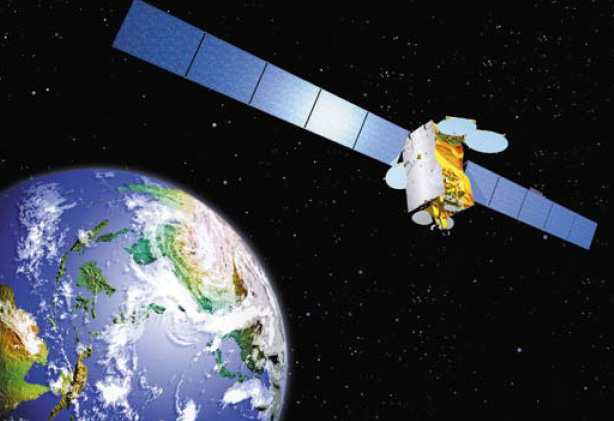
Manufacturer: EADS Astrium

Description and Purpose:
Arabsat 5B (Badr-5) is a new broadcasting satellite built by EADS Astrium for Arab Satellite Communications Organization, ARABSAT. The spacecraft will be co-located with Badr-4 and Badr-6 Direct-To-Home satellites at ARABSAT’s 26° east longitude video “hot-spot”. Badr-4 and Badr-6 were deployed in 2006 and 2008, respectively.
The new satellite will guarantee to ARABSAT’s broadcasting customers a unique “hot” redundancy, the highest level of service provided within the Middle East and North Africa (MENA) region. Complementary capability will include supporting the projected expansion of HD-TV broadcast and the development of sophisticated interactive services.
Based on Astrium’s Eurostar E3000 platform, Badr-5 hosts 56 active transponders in Ku-band and Ka-band. The satellite has a launch mass of 5,420 kg and a spacecraft power of 14kW at the end of its 15-year service lifetime.
Eng./Khalid bin Ahmed Balkhyour President&CEO of Arabsat has stated that BADR-5 satellite is a multi-loads, services and coverages as it was designed to serve the Arab world and the neighborhood regions through a number of varied coverages (beams) and through the different frequencies in the KU- band and the Ka-band that provide (Direct - to - home) services and (Interactive TV) and (internet broadband services) with additional capacities to accommodate the expected demand for HDTV (High - Definition TV ).
Balkheyour added that Arabsat new Bader -5 capacities will provide a full backup in the orbit for the satellites currently operating in Arabsat exclusive Hot Spot 26 degrees East, plus the ability to meet the increasing demands and expansion in the future, as this satellite alone can transmit more than 700 TV channels and at the same time provide various satellite communications services, including the Internet.
Balkheyour also said that by the end of the same month (June 2010) the second satellite of the fifth-generation (5-A) will be launched in the exclusive orbital position of Arabsat 30.5 degrees East, which covers the whole continent of Africa and large parts of Asia as well as covering the Arab world fully and distinctly.
Thus, Arabsat has achieved integration in providing of space-based services as it is considered the only organization in the region that has a highly qualified and integrated fleet of satellites providing all Satellite communications and television broadcasting services.
Arabsat 5B (Badr-5) Specifications
Orbital Location|26° East
Platform|Star-2.4
Launch Mass|5,420 kg
Mission Life|15 years
Power (End of life)|14 kW
In-Orbit Dimensions|8.3 m x 39.4 m x 4.51 m
Payload
Number of Transponders|56
Ku-band / BSS Uplink|17.3–18.1 GHz
Downlink|11.7–12.5 GHz
Ku-band / FSS Uplink|13.75–14.0 GHz, 14.0–14.5 GHz
Downlink|10.95–11.2 GHz, 11.45–11.7 GHz, 12.5–12.75 GHz
Ka-band / FSS Uplink|27.5–28.6 GHz, 29.1–30.0 GHz
Downlink|17.7–18.8 GHz, 19.3–20.2 GHz
Beam footprint information

Launcher: Proton-M with Briz-M upper stage

Rocket Family|Proton
Designation|8K82M
Class|Heavy
Type|Expendable
Designer|Salut Design Bureau
Manufacturer|Khrunichev State Research and Production Space Center
Stages|4
Height, mm|42340
Diameter, mm|7400
Launch Mass, kg|700000
Arabsat 5B (Badr-5) Ascent Profile and Breeze-M Powered Flight
The upper stage follows a five-burn injection profile.
The first burn occurs 94 seconds after the separation from the rocket, forming a support orbit. The second ignition is performed in the first ascending node of the support orbit, resulting in an intermediate orbit.
Following a revolution along the intermediate orbit, the upper stage performs the third and fourth burns, which form a transfer orbit with an apogee close to that of the final orbit. The additional propellant tank is separated between the third and fourth burns. The fourth burn occurs 137 seconds after the third cutoff.
The fifth burn is performed in the transfer orbit apogee, placing the AU into the target orbit.
Before each burn and before APT separation, correction motors ignite for fuel compression.
Once in the target orbit, the ascent unit is stabilized for Arabsat 5B (Badr-5) separation, following which the satellite is released.
After craft separation orbit parameters are analyzed, and the upper stage is withdrawn to drift in a safety mode (pressure in all the containers is dropped).
The Proton/Breeze-M powered flight lasts 33,180 seconds (9 hrs 13 min).
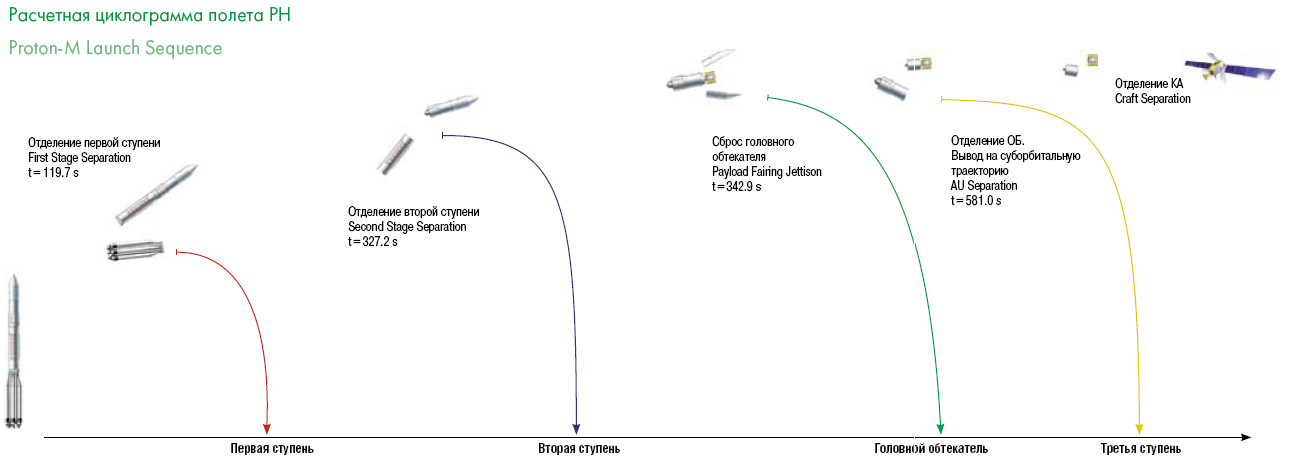


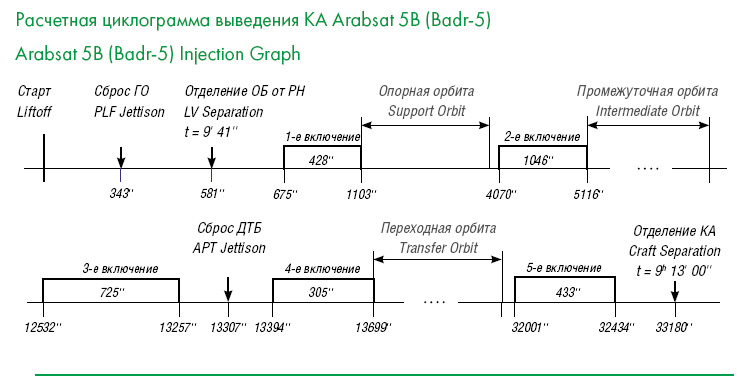
Ascent timeline:
Ignition Start Sequence|-00:00:02.5|
Stage 1 Ignition (40% thrust)|-00:00:01.75|
Command Stage 1 (100% thrust)|-00:00:00.9|
Maximum Dynamic Pressure|00:01:03|
1st/2nd Stage Separation|00:02:00|
2nd/3rd Stage Separation|00:05:27|
Payload Fairing Separation|00:05:46|
3rd Stage/Breeze M Separation|00:09:41|
1st Burn Ignition|00:11:15|
1st Burn Shutdown|00:18:24|1st Burn's Duration 00:07:09
2nd Burn Ignition|01:07:50|
2nd Burn Shutdown|01:25:16|2nd Burn's Duration 00:17:26
3rd Burn Ignition|03:28:52|
3rd Burn Shutdown|03:41:01|3rd Burn's Duration 00:12:09
APT Jettison|03:41:51|
4th Burn Ignition|03:43:18|
4th Burn Shutdown|03:48:19|4th Burn's Duration 00:05:01
5th Burn Ignition|08:53:21|
5th Burn Shutdown|09:00:34|5th Burn's Duration 00:07:13
Spacecraft Separation|09:13:00|
The vehicle's reliability statistics according to http://www.spacelaunchreport.com/reliability2010.txt:
Code:
================================================================
Vehicle Successes/Tries Realzd Pred Consc. Last Dates
Rate Rate* Succes Fail
================================================================
Proton-M/Briz-M 35 38 .92 .90 16 03/14/08 2001-Weather forecast for Baikonur, Kazakhstan on June 4, 2010
Hi: 30°C
Lo: 18°C
There is a 0% chance of precipitation. Partly cloudy. Warm. Temperature of 30°C. Winds NNW 11km. Humidity will be 31% with a dewpoint of 11° and feels-like temperature of 29°C.
Sunrise/Sunset and associated twilight times for Baikonur on Friday, June 4, 2010
Times are local.
Astronomical twilight begins|03 : 24
Nautical twilight begins|04 : 30
Civil twilight begins|05 : 20
Sunrise|05 : 56
Transit (sun is at its highest)|13 : 45
Sunset|20 : 46
Civil twilight ends|21 : 09
Nautical twilight ends|21 : 59
Astronomical twilight ends|23 : 05
MORNING TWILIGHT LAUNCH!
Good spotting opportunities for Eastern Kazakhstan, Russian Mountain Altai Republic, Northern Mongolia and Russian Buryat Republic:
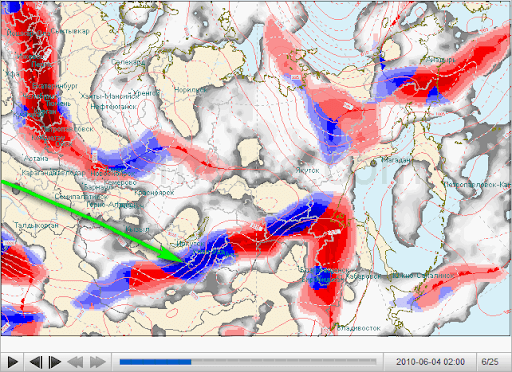
Watching the launch live
ILS broadcast will at 21:30 UTC (5:30 p.m. EDT)
TSENKI broadcast will begin at 00:05 MSK (20:05 UTC) and end at 03:00 (23:00 UTC)
- ILS Launch Services http://badr5.imgondemand.com/
- Khrunichev COOPI: http://coopi.khrunichev.ru/main.php?id=200
- Space Center Website Video: mms://www.space-center.ru/video
- TSENKI Video Streams: http://www.tv-tsenki.com/livechoose.php
References
http://www.federalspace.ru
http://tvroscosmos.ru
http://www.ilslaunch.com
http://www.khrunichev.ru
http://coopi.khrunichev.ru
http://www.arabsat.com
http://forum.nasaspaceflight.com
http://www.novosti-kosmonavtiki.ru
http://www.spacelaunchreport.com
http://weatherbug.com
http://www.good-stuff.co.uk/suntimes/sunmap.php











